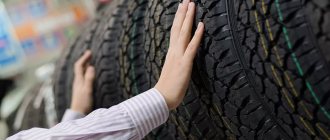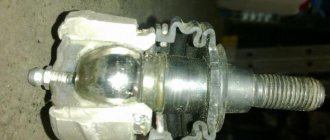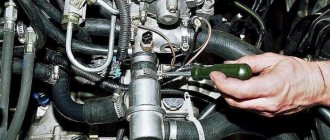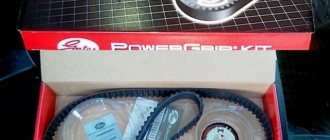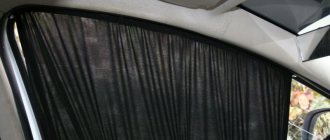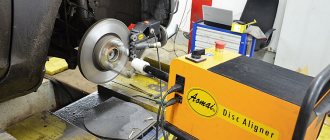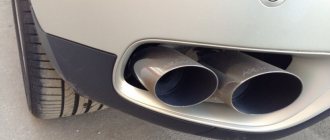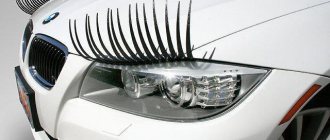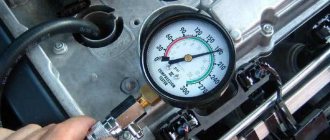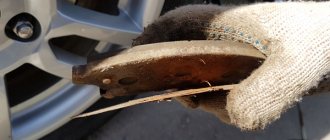A properly functioning car brake system is the key to safety and comfortable movement. Despite the fact that most modern technical equipment is equipped with digital sensors to monitor the performance of components, the driver is also responsible for maintaining the machine.
Most often, brake pads, friction linings, and discs wear out. Therefore, it is important to comply with the timing of the technical inspection. For each car, the manufacturer specifies individual maintenance and replacement intervals.
The design of the brake system is not complicated, and the operating principle is intuitive. But, without the skills, it’s better not to take risks. Unprofessional intervention leads to system malfunction.
How to grind (grind) brake discs yourself
Systematic use of the brake disc leads to uneven wear. This process is not a defect, a marriage, rather a natural factor.
Abrasive grooves along the perimeter reduce braking efficiency, making driving a car unsafe. There are two ways to restore the brake circuit:
- Replace the disk with a new one;
- Grind the installed (factory) one.
Obviously, in the first case, you need to purchase a set of new parts, which not everyone can do due to the relative high cost. Grooving, as an alternative option, is quite acceptable.
It is almost impossible to do this at home, as you will need special equipment.
Growing brake discs is a good ADDITIONAL way to earn money.
WHY IS IT IMPORTANT TO RESTOR THE GEOMETRY OF BRAKE DISCS For a modern car, it is very important that all elements of the brake system are in accordance with factory specifications. Why? Because the developer of brake systems, when designing and ensuring the most efficient operation, is based precisely on factory specifications. In particular, the tolerances for lateral runout of a new brake disc installed on the hub should not exceed 0.05 mm (50 microns), which is 2 times thinner than a human hair. It is these characteristics that ensure the most effective braking and absence of vibrations. The beating of the disc on the hub (it’s easy to imagine, remembering the “figure eight” on the front wheel of a bicycle in childhood) causes the disc to constantly touch the pads, even when the brake pedal is released. Very quickly, constant contact leads to wave-like wear on the surface of the brake disc, which causes vibrations on the steering wheel and pulsations on the pedal when braking. Why exactly does wave-like wear lead to pulsations in the pedal when braking and even vibrations in the steering wheel and, sometimes, the entire front part of the car? The reason is the brake fluid, which, like all fluids in nature, is practically incompressible. When you press the brake pedal, the entire “relief” of the brake disc is transferred through an incompressible fluid to the pedal - like the profile of the road surface to the suspension.
In addition, wave-like wear reduces the contact patch between the pad and the disc, which leads to reduced braking efficiency and a longer braking distance. These symptoms are known to any driver after 15,000-20,000 km of a new car, not to mention further use.
The fact is that during the operation of the car, the hub itself is deformed from impacts from the road surface. These deformations can be easily identified by installing a new brake disc to replace the worn one. The micrometer will immediately detect runout on an ideal factory disc! That is, wave-like wear on the surface of the new disc will appear in the near future, and the car owner can attribute the vibrations that appear during braking to the quality of work in the service center or installed spare parts.
Is there a way out of this situation? Of course have!
Cutting the new disc 0.1-0.2 mm with cutters completely restores its ideal rotation relative to the caliper and pads. In this case, paradoxically, the resource will only increase, because subsequently the disc will have to be sharpened even more to eliminate runouts and ensure “factory” braking efficiency. There is one more important detail: most cars today are equipped with ABS, traction control and anti-skid systems. These systems use brakes, or rather a pair of “Brake disc-pads” , braking one or another wheel during acceleration, braking or skidding. The operating algorithm of the systems provides for the correct, “factory” condition of the disc and pads. If the braking system loses efficiency, so do these vital systems today. Their work becomes rougher, less accurate, or completely disrupted. This explains the “tightening” of automakers’ requirements for the geometry of brake discs: - Violation of the disc plane is no more than 0.05 mm (50 microns), - Lateral runout is no more than 0.025 mm (25 microns), - The difference in thickness along the average diameter is no more than 0.005 mm (5 micron).
WHAT DOES TURNING BRAKE DISCS GIVE 1. The wear of new pads is noticeably reduced. 2. The ineffectiveness of the braking process disappears during the first 100-200 km, which reduces the likelihood of emergency situations while traveling. 3. During emergency braking, the braking distance is noticeably reduced. 4. The effectiveness of ABS, as well as traction control and anti-skid systems of the car increases.
BRAKE DISC TURNING AS A BUSINESS
There is competition in the brake disc turning service market, but it is not great, and every car service owner understands that it is important to enter this market as early as possible in order to stake out a position and attract customers with quality service.
In Moscow, turning one disc today costs from 700 rubles (for domestic cars) to 1200 rubles per disc and more. Thus, for all four wheels from 2800 rubles. And one more important factor. Grooving brake discs is, as a rule, an ADDITIONAL service, that is, additional money.
Don't give it to your competitors, EARN THIS MONEY YOURSELF!
With AE&T© equipment this is real!
https://aet-auto.ru/catalog/dopolnitelnoe-oborudovanie/oborudovanie-dlya-remonta-tormoznyix-i-kolyosnyix-diskov/stanok-dlya-protochki-tormoznyh-diskov-am-983.html
https://aet-auto.ru/catalog/dopolnitelnoe-oborudovanie/oborudovanie-dlya-remonta-tormoznyix-i-kolyosnyix-diskov/stanok-dlya-protochki-tormoznyh-diskov-am-8700.html
Diagnostics
Before starting, the technicians conduct a comprehensive diagnostic to study the general technical condition of the machine and identify breakdowns. Based on the data obtained, the number of necessary spare parts and other consumables is calculated.
It often happens that, along with the discs, pads, friction linings, circuit lines, and cuffs need to be replaced. An objective approach will help avoid breakdowns in the future.
You need to think about turning discs after 90 - 100 thousand km. car mileage. If you drive aggressively, “repairs” will be required earlier than expected.
Come to Autostar to replace pads and discs
The AutoSTAR car service center has been operating in Moscow since 1998; competent specialists will quickly diagnose the condition of your car and competently replace the pads and discs. We have accumulated solid experience in servicing and repairing foreign cars.
Our advantages:
- use of original or alternative high-quality foreign materials and parts
- high level service
- extensive experience as auto mechanics
- warranty on all work and spare parts
- reasonable prices
By entrusting your car to us, you save your time, money and nerves. The convenient location of the auto repair center in the Koptevo area allows car owners to quickly drop off and pick up their car at a convenient time.
Signs of early disc wear
- Increased operating temperature, frequent heating. To check by touch, just touch with your palm;
- Driving a car is accompanied by a metallic grinding and whistling sound in the area where the brake disc is located;
- The natural braking distance is increased by 10 - 15% or more;
- When the speed decreases, vibration is transmitted to the steering wheel;
- When the wheel is removed, traces of wear and corrosion on the disk are visible.
If you find one or more signs, contact a service station for diagnostics and subsequent replacement of worn elements.
Grooving is carried out without removing the disk from its original place. It is enough to have a machine, a hydraulic jack, and a wheel wrench.
If the excavation has reached critical dimensions, as determined by the master, dismantling the disk is mandatory. Next, it is fixed on a lathe, turned, and abrasive workings are removed.
There is a third option - cutting it yourself with a file, but no one can guarantee success.
No removal.
Modern equipment and technologies have led to the fact that today it is possible to carry out grooving without removing the rims from the car; by the way, this method is the main and most widespread at present. It is very convenient that a modern machine for turning discs, in addition to its main purpose, itself adjusts all the necessary parameters for balancing and thickness of the brake disc. However, if the brake discs are still removed, they are processed on a special machine with a horizontal plane on both sides.
As a result of professional turning of brake discs, we get the following:
- increasing the efficiency of the braking system;
- elimination of brake disc runout;
- increasing the service life of brake discs;
- saving money in the family budget.
How does the disc grinding process work?
- The car is placed within the perimeter of the service station repair area and hung on a lift;
- Provide priority safety measures, squeeze the parking brake;
- Unscrew the bolts and remove the wheel;
- The shaft is fixed on the pin axis, the emery is applied, and the machine is started at minimum speed.
The rotation speed is increased as needed, depending on the size of the furrows. To prevent overheating, we recommend periodically watering the disc with running water.
The cycle of the operation is determined by the master, based on personal experience. The brake disc is not subject to further use if its actual thickness is less than 2/3 of the original thickness.
Recommendations for servicing the brake system
- Strictly observe the timing of inspections and preventive maintenance;
- Purchase original parts and their analogues according to the catalog numbers specified in the operating instructions;
- Avoid excessive wear of the friction lining and pads;
- Install new pads in pairs;
- Avoid getting into holes, bumps, potholes at medium and high speeds.
The cost of the disc pumping service is negotiated individually with the service station manager. A number of factors influence price formation:
- Degree of wear;
- Furrow depth;
- Presence of corrosion;
- Deformation, third-party mechanical damage.
In parallel with the restoration of the discs, inspect the friction linings, working cylinder, and pipes. If there are defects or cracks, replace the parts with new ones. It is unacceptable to use a technical device with a faulty brake system.
Once boring is complete, bleed the brake circuit. This is necessary to adjust the tightness of the pad to the disc body. Replace the fluid if sediment, cloudiness, or discoloration are visible. In cars produced after 2000, the brake circuit is filled with DOT-4 class fluid. The volume varies from 1.0 to 1.5 liters depending on the brand.
When is re-grooving a car's brake discs allowed in Moscow?
After a car has traveled hundreds of thousands of kilometers, you should not think that it is possible to get by with small and inexpensive repairs. There are points due to which repair is impossible:
- The presence of cracks (will lead to very serious consequences);
- Serious wear and tear (the entire system may overheat, reducing efficiency and safety);
- Thin disk (turning reduces the thickness of the “pancake”, and if it already has a small thickness, then deformation cannot be avoided).
- You can consult on this matter by calling the indicated phone numbers. The company's managers will answer all your questions and give all the necessary recommendations.
Also, without leaving your home, you can make an appointment with the best mechanics at one of the car repair shops in Moscow for diagnostics of your running car . To do this, fill out the form by clicking on the appropriate “ Register online ” button.
